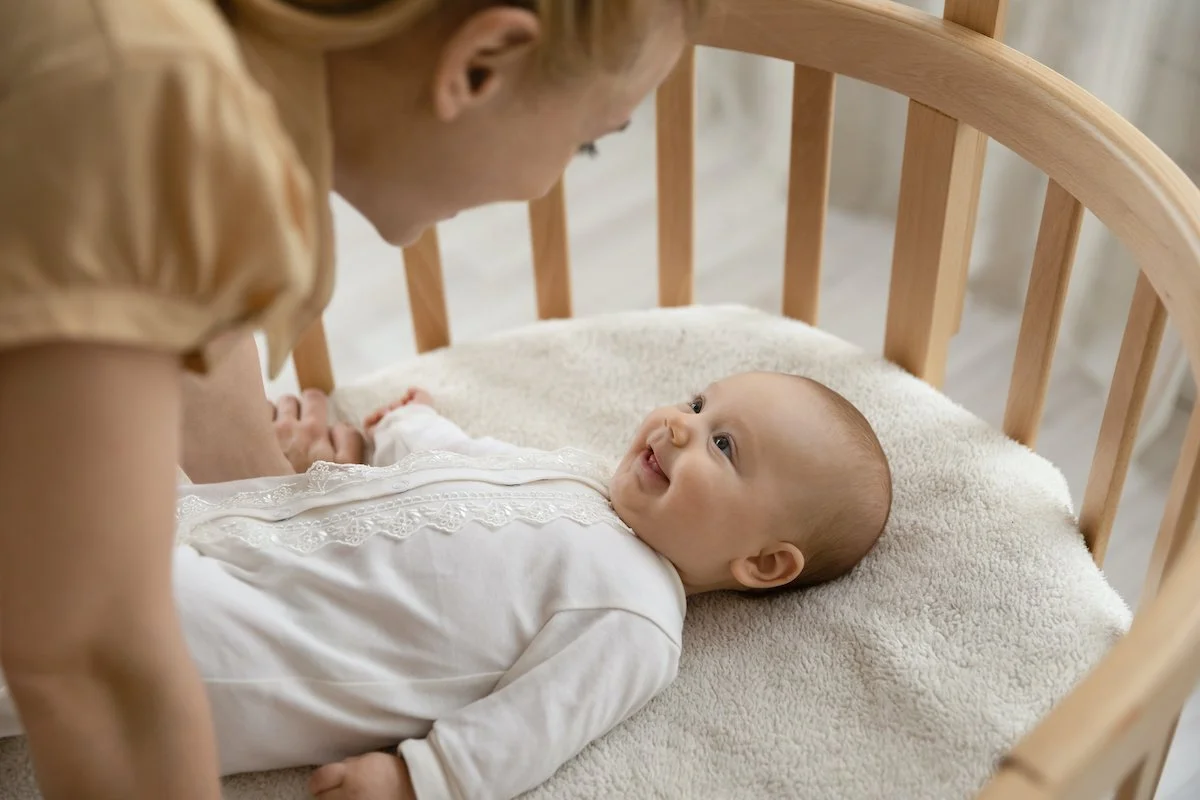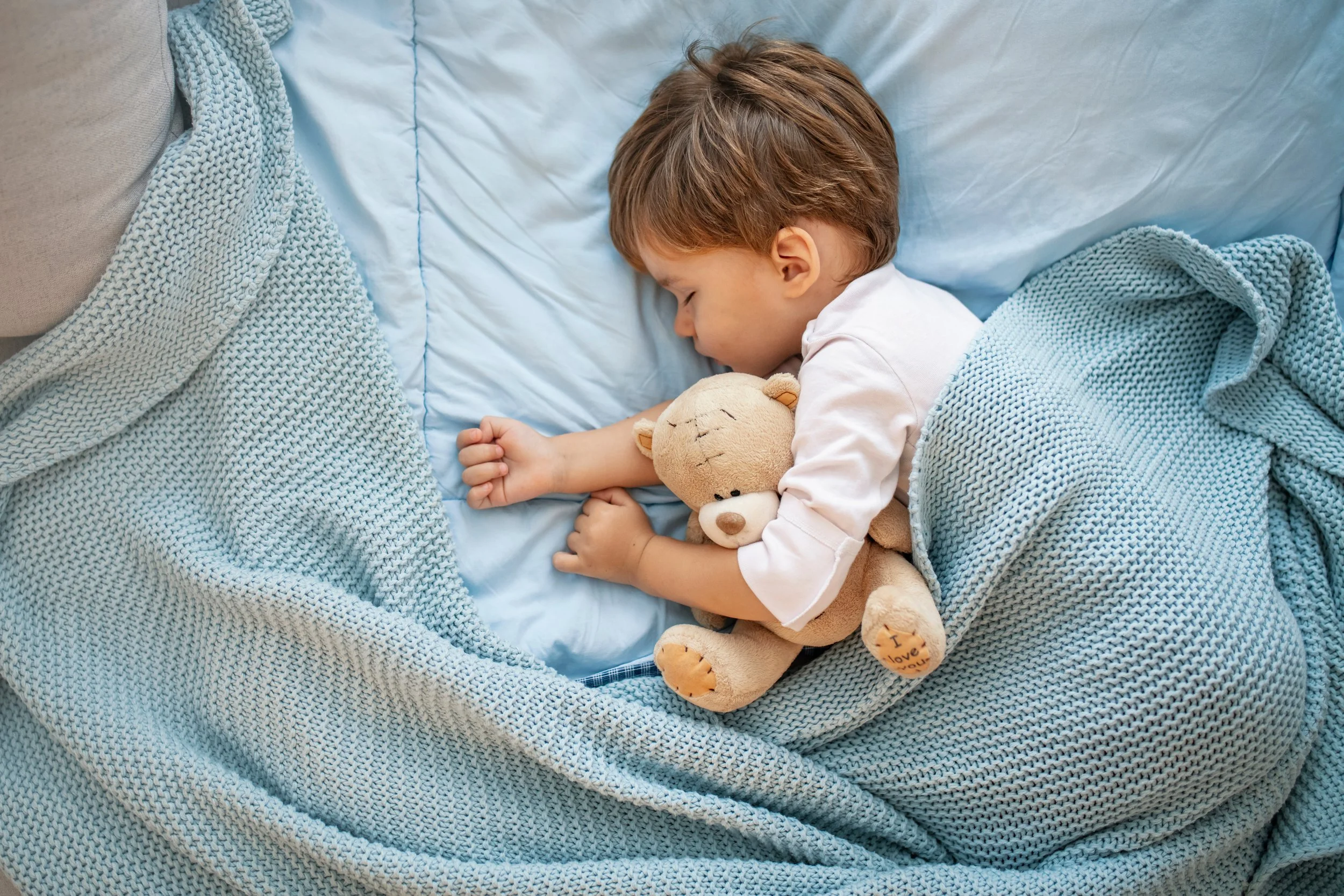How to Handle Separation Anxiety in Babies and Toddlers While Sleep Training
By: Melissa Bramwell, SENIOR Sleep Consultant
Ahh, separation anxiety. It’s one of the number one topics we’re asked about the most when it comes to sleep training. Often, just the thought of a child’s separation anxiety can deter a family from taking the next step for teaching their child independent sleep. But I’m here to tell you: you can help your child through this and still sleep train successfully!
The key here is having the knowledge for how to handle separation anxiety so that you can best support your child during this time. In this post, I’ll talk about separation anxiety, what it looks like for your infant and toddlers, and how to sleep train while going through it.
What is Separation Anxiety?
When you notice more signs of your infant or your toddler becoming more clingy, this is a clear indication of separation anxiety. They might cry a little bit more when you leave a room, or when you pass them off to another person or caregiver, or maybe you put them down after holding them and they become visibly upset and frustrated.
Signs of Separation Anxiety
Babies
Often occurs around 6-7 months old, 9-10 months old, and 12-14 months old
Baby becoming clingier
Baby cries when you leave the room
Baby becomes visibly frustrated when no longer held, or when handed to another caregiver
Toddlers
Often occurs around 2 years old or after a big change (i.e. welcoming a new sibling, move to new home, move to toddler bed, starting preschool, etc.)
Toddler becoming clingier
Toddler becomes frustrated, stubborn, or upset when you leave
What Causes Separation Anxiety in Children?
Separation anxiety is often related to physical and cognitive developmental milestones. This is especially true as babies reach 9-12 months old. This is when some babies are just learning to pull themselves up and stand, or even to walk. There is so much happening in their tiny bodies and they become more aware of their routines. Along with this comes stranger anxiety, as babies are well aware of who their primary caregivers are (you!!)
If you meet with someone new, or you're around friends and family who your child does not see a lot, and your baby becomes more hesitant, upset, or starts crying, this is normal. Your baby doesn't know this new person.
Understanding Object Permanence
At the 6-7 month mark, a big milestone occurs: object permanence. Your baby is starting to understand what it means for an object to leave and come back. You may notice this when you are playing with your baby and you leave the room: they cry a little bit, but as soon as you come back, they're happy again and it's like nothing ever happened. They're learning that when you leave a room, it doesn't mean that you're gone for good. You will come back.
You can help teach your baby object permanence in other ways too, such as hiding a toy under their blanket or behind your back, then “reappearing” the object; this teaches some cause and effect, as well.
Two Main Questions:
“My child is experiencing a decrease in sleep and I think they're going through separation anxiety. Is this normal?”
Yes! You can expect to see a regression when your child is experiencing separation anxiety. They may wake more during the night looking for you. Their naps may become short. They may even seem more upset once you enter their room. These are just a few things that you may see happen with your little one. Don’t worry, it is normal, it's totally okay, and you will get through it!
“Can I still sleep train while my child is experiencing separation anxiety?”
Also, yes! It is normal to feel upset or to feel like you are abandoning your child when they're going through the separation anxiety. Your feelings are valid. It's hard. No one ever wants to see their child cry and be so upset, and it's easy to “fix” the solution by just resorting to holding your child baby the whole day, or giving in to your toddler. But this is not sustainable.
The sooner you are able to sleep train (or if you’ve already sleep trained, then the sooner you can get back on track), the better for your child’s sleep and for your mental health (and your sleep, as well!)
Best Sleep Training Method for Separation Anxiety
We teach a supportive approach at Kelly Murray Sleep. We offer comfort intervals for your child, and we also offer both an in-the-room approach and an out-of-the-room approach.
If your little one is experiencing separation anxiety, we can start with a more supportive approach, which takes place in the room. The way this looks during the sleep training process is that you start in the room by your child, and every few nights, you move further and further away from them. This way, you gradually offer more space until eventually, you are out of the room. What this is doing is giving your young ones support, letting them know that you are near and able to support them with those comfort intervals, but you aren't assisting them them to sleep (i.e. rocking baby to sleep, rubbing toddler’s back to sleep, etc.) It's usually hard for just a couple of days or so, and then it gets easier again.
Pro Tip: it's always nice to have a mantra to remind yourself that you're doing this for your family's sleep and to make things better for everyone.
Tips for Managing Separation Anxiety
1. Make sure YOU maintain your naptime and bedtime routineS
This needs to be consistent across the board with all caregivers. This may differ a bit if your child is in daycare during their naptime, and that's okay. But when your child is with you, sticking to their naptime and bedtime routines is going to help maintain a sense of familiarity, which will help separation anxiety pass more quickly.
2. Spend more awake time in the sleep environments where your child is having a hard time
If your young one is super upset when you enter their bedroom, or perhaps they seem to not like spending time in there, it can indicate they have an anxiety about their room. They may be associating the fear of you leaving with that environment. A way to work through this is to try to spend a little bit more wake time in the room during awake hours.
For example, as soon as you get your child up in the morning, start by opening the shades to wave and say hello to all the animals, to nature, and to the cars outside. Then, throughout the day, have some play time in the room. I usually suggest to keep it a little less stimulating play so that they don't associate their room with a fun, super energetic playroom. Instead, consider reading books, building with blocks, or playing with basic toys that don't have any lights or sounds.
3. Use a key phrase
It can be helpful to incorporate a key phrase before all sleep situations, as well as anxiety-provoking situations, that’s both reassuring and validating to your child’s feelings. Having a phrase that tells your child they’re loved, that mom/dad is near, and that bed is safe, can be very helpful in making them feel validated, reassured and secure.
4. Incorporate objects into the sleep environment that remind your child of you
It is normal for your child to want their parent to stay in their sleep environment. Especially toddlers, who are able to vocalize this more than babies can. One helpful tip is to hang pictures in the room of you with your child, or you can even give them an item of yours to hold in their crib, such as a shirt or scarf. If they have a lovey they sleep with, you can tie the item onto the lovey. Some clients have found success giving their child their own pillow! Then, before bed, you can tell a family story or share some happy memories that you’ve have together. In doing all of this, you're helping create this new positive association in your child's brain right before they are going to bed.
5. Offer 10-15 minutes of uninterrupted one-on-one time
Research shows that just 15 minutes of uninterrupted one-on-one time with your child can do wonders for their behavior. This can be with just one parent or caregiver at a time and will “fill their cup”, making them feel appreciated and seen.
6. Play Peek-a-Boo & Give Moments of Independent Play
As I mentioned before when discussing object permanence, a great way to help babies with this developmental milestone is to play peek-a-boo with them. Try hiding behind the couch and peek out to your child. They will start to learn that an object disappears and comes back.
For toddlers, you can stretch this into giving them moments of “away time” from you. For example, you can let them know you’re going to go to a different room briefly and that you’ll check on them in just a moment. This might look like, “Hey, sweetie, I'm going to go to the bathroom. I'll check on you when I'm done,” or, “I'm going to do a couple dishes. I'll be right back.” Then, you check on them every couple of minutes and see how they are doing. This way, you are giving them a little space to focus on independent play, and they’ll begin to build trust in knowing that you will always coming back.
7. Tell your child when you are going away
It isn’t always helpful to “sneak away” from your child when another caregiver is taking over their supervision. Instead, verbally announce that you are leaving and incorporate a brief goodbye ritual that you do every time you go.
This isn’t to say that your child won’t be ok if you sneak away; they may be fine and happy for a bit, but 20 minutes into playing, they may start to wonder where you are and realize you have left. They become confused and, in turn, really upset, which is valid! Instead, start to build trust with your child by letting them know what to expect when you leave.
For example, if you are leaving to go to dinner and your child will be watched by another caregiver, try telling them, “We’re going out and you're going to stay with grandma and we are going to be back. I can't wait to hear about everything that you did.” After doing this several times, your child learns to feel secure and trust the process.
Getting Back on Track After Separation Anxiety
If you do decide to sleep train while your child is experiencing separation anxiety, please remember that it will pass. If you are able to avoid picking up new sleep props or associations, it's going to pass much more quickly. Especially for those children who are already sleep trained — it is so important to avoid introducing new sleep props and associations as “bandaid” solutions to help ease separation anxiety. It may be easier in the short term, but in the long run, it is not sustainable.
Instead, lean on those independent sleep training strategies! Do those check-ins, offer comfort in intervals, and knowing that your family will be make it through this challenging time. Stay firm, stay committed, and practice these tips I have laid out. I promise that if you do so, this will pass quickly.
Remember: most of all, you are an amazing parent and your child loves you so much.
Have a Stage-5 Clinger and Need Support Sleep Training?
That’s what we’re here for! We can help guide you through this time while your child learns how to trust that you will be there, even if you are just a couple rooms away at night. If you need support, please give us a complimentary discovery call so that we can learn more about your situation and explain our approach. That way, you can decide if we’re the right fit for you and your family.
All team members have completed training with Kelly and have learned the Murray Method. Kelly continues to support, guide and oversee the Sleep Squad as they work with the families who trust in us. This way, all clients are able to experience the same amazing results (and lots and lots of sleep).
Sweet Dreams…
Kelly Murray is a certified sleep coach and an award-winning pediatric sleep consultant based in Chicago offering sleep coaching services nationwide.

















